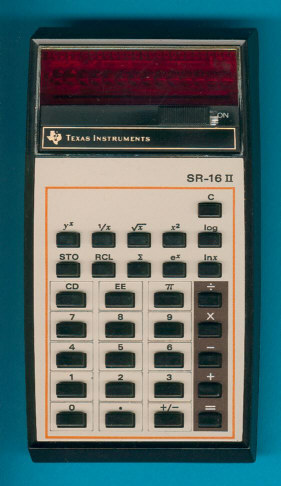
DATAMATH CALCULATOR MUSEUM
 |
DATAMATH CALCULATOR MUSEUM |
Texas Instruments SR-16 II
| Date of introduction: | August 1975 | Display technology: | LED-stick |
| New price: | $49.95 | Display size: | 8 + 2 |
| Size: | 5.8" x 3.2" x
1.3" 147 x 81 x 32 mm3 |
||
| Weight: | 5.7 ounces, 163 grams | Serial No: | 204909 |
| Batteries: | 3*AA | Date of manufacture: | wk 44 year 1975 |
| AC-Adapter: | AC9180 | Origin of manufacture: | USA |
| Precision: | 8 | Integrated circuits: | TMS1016, 2*SN27882 |
| Logic: | Chain | ||
| Memories: | 1 | ||
| Program steps: | Courtesy of: | Joerg Woerner |

![]() The
SR-16 II followed soon in the steps of the rare and famous SR-16.
It uses a very similar housing to the SR-50A but gives a
rather boring appearance with the few black keys and the printed keyplate. The rare
SR-40
prototype was sandwiched between the SR-50A
and SR-16 II.
The
SR-16 II followed soon in the steps of the rare and famous SR-16.
It uses a very similar housing to the SR-50A but gives a
rather boring appearance with the few black keys and the printed keyplate. The rare
SR-40
prototype was sandwiched between the SR-50A
and SR-16 II.
This SR-16-II introduced in 1975 gave already a first impression of the best-selling Texas Instruments scientific calculator ever, meet the TI-30 introduced in 1976.

 Dismantling
the featured SR-16-II manufactured in October 1975 by Texas Instruments in their
Lubbock, TX facility reveals a very clean design centered around a
TMS1016
single-chip calculator circuit, supported by two
SN27882 digit drivers for the 12-digit LED display and powered by three
AA-sized alkaline batteries with a simple step-up converter.
Dismantling
the featured SR-16-II manufactured in October 1975 by Texas Instruments in their
Lubbock, TX facility reveals a very clean design centered around a
TMS1016
single-chip calculator circuit, supported by two
SN27882 digit drivers for the 12-digit LED display and powered by three
AA-sized alkaline batteries with a simple step-up converter.
![]() The TMS1016 is
actually one of the few calculator applications of the famous
TMS1000 Microcomputer family introduced in 1974, later products used usually
modifications of the TMS1000 to reduce manufacturing costs.
The TMS1016 is
actually one of the few calculator applications of the famous
TMS1000 Microcomputer family introduced in 1974, later products used usually
modifications of the TMS1000 to reduce manufacturing costs.
A rare sibling of the SR-16 II was sold with the CONCEPT
III. All three
known CONCEPT models based on Texas Instruments calculators seem to be very rare, don't miss the CONCEPT
I and CONCEPT
II.
You'll find similar calculators in the Basic-Album, view for example the TI-2550 II. Very unusual is the poor calculating precision, the internal resolution is only 8 digits. If you are interested in the calculating accuracy of scientific calculators don't miss the Calculator forensics.
If you have additions to the above article please email: joerg@datamath.org.
© Joerg Woerner, December 5, 2001. No reprints without written permission.